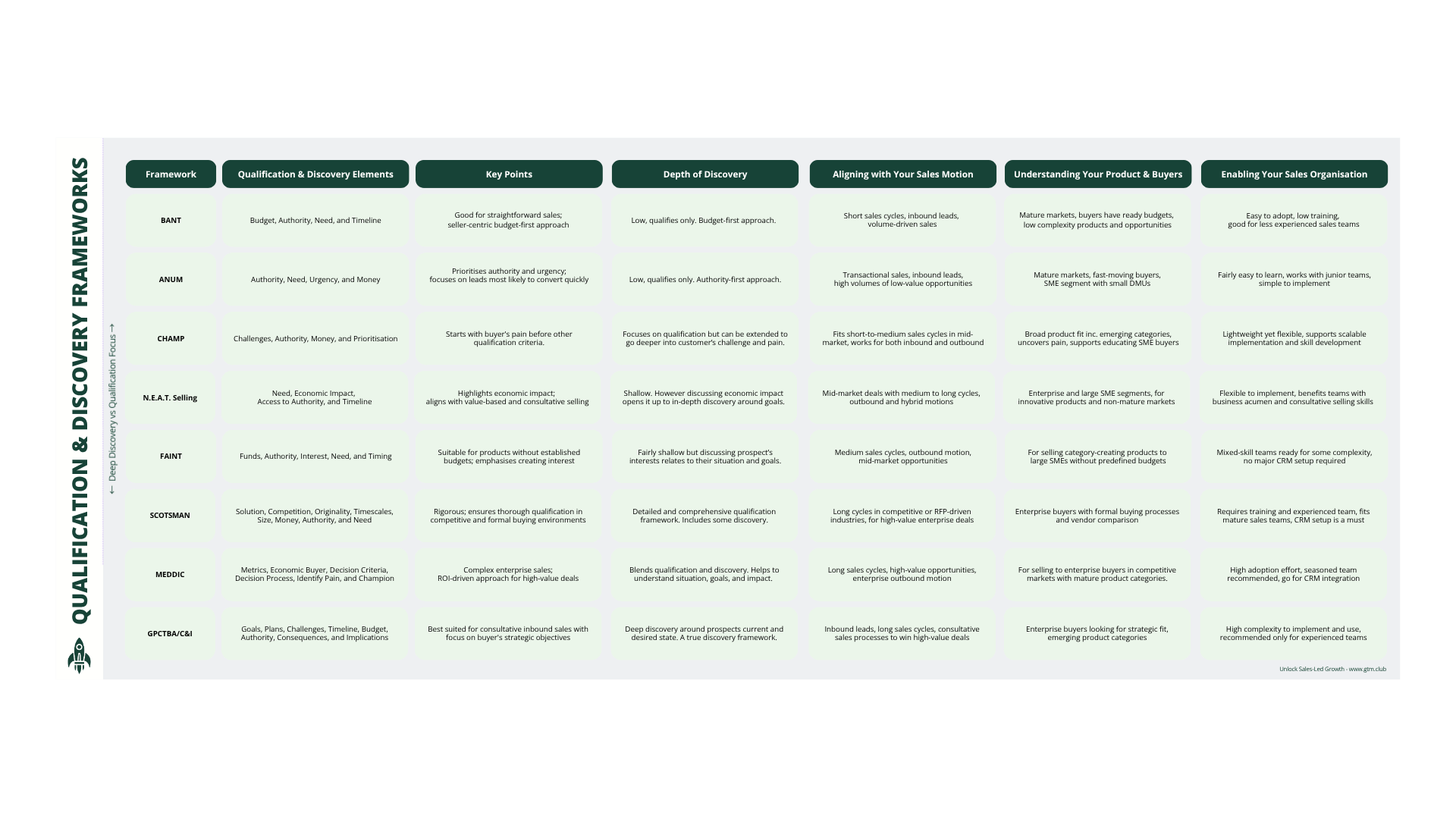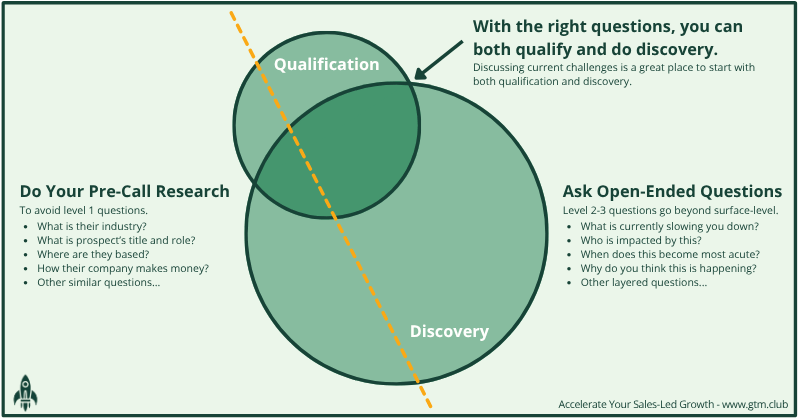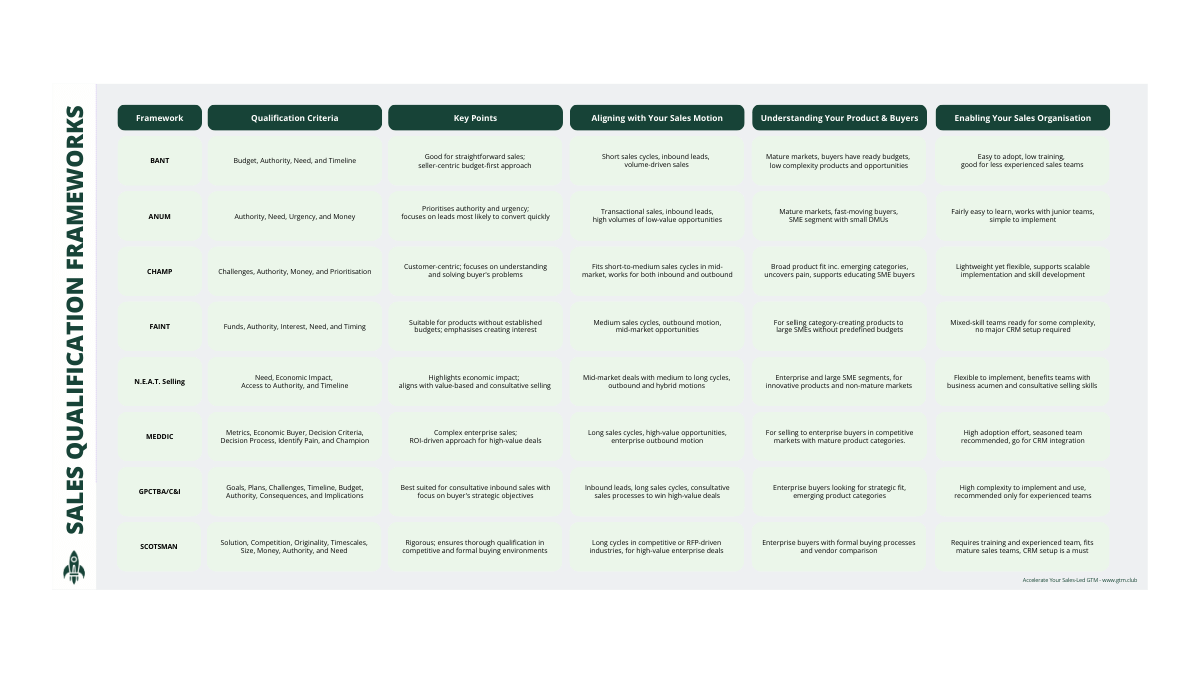The Complete Guide to Choosing a Sales Qualification Framework
Choosing the right sales qualification and discovery framework helps your team focus on the right opportunities. This guide compares BANT, MEDDIC, CHAMP, and five other frameworks so you can pick the best one for you based on how you sell, your product's complexity, and your sales team's experience.

Selecting a sales qualification and discovery framework is essential to focusing your go-to-market team on the right prospects and opportunities. Frameworks range from simple, think of BANT, to comprehensive, like MEDDIC. The best choice depends on multiple variables such as sales cycle, customer profile, product-market fit and skill levels within the sales organisation.
Choosing between sales qualification frameworks requires careful consideration, as each serves different purposes and contexts. While all frameworks share common elements like assessing customers' needs, decision-makers, financial capability and urgency, they vary in complexity, depth and priorities.
To help you select the most suitable qualification framework, GTM Club's Guide covers the following:
- Why are there so many sales qualification frameworks to choose from?
- How does a sales qualification framework benefit your go-to-market?
- Free Download: Our guide for choosing your qualification framework
- How does the way you sell impact the selection of the sales qualification framework?
- How are the target market and product relevant when choosing the sales qualification framework?
- How to select the best sales qualification framework for your sales team?
- How to start with the selected sales qualification framework?
Check out some of our qualification framework breakdowns (BANT, ANUM, CHAMP, N.E.A.T Selling™, FAINT, MEDDIC, GPCTBA/C&I, and SCOTSMAN®) and the article about different qualification criteria and discovery themes.
Why Do Different Sales Qualification Frameworks Exist?
BANT was invented in the 1950s. Since then, selling and buying have changed, and sales qualification frameworks have evolved to meet changing needs. For example, MEDDIC was born in the 1990s, and N.E.A.T. Selling just a few years ago.
While initial frameworks were designed for simple transactional sales, newer methodologies have emerged to handle everything from straightforward product sales to complex enterprise solutions involving multiple stakeholders and lengthy sales cycles. This evolution has produced a range of frameworks, each optimised for different sales scenarios and offering distinct advantages. For example:
- Simple vs. complex sales: Basic frameworks like ANUM work nicely for straightforward sales, while comprehensive frameworks like SCOTSMAN suit complex enterprise deals.
- Different sales methodologies: Companies sell differently. Some invest in acquiring inbound leads, while others lean on outbound activities to meet growth targets. Outbound prospects and inbound leads need to be handled differently.
- Sales Process Maturity: Organisations at different maturity levels need qualification frameworks that match their capabilities, goals and processes.
Benefits of Using a Sales Qualification Framework
Using a structured qualification framework provides several key advantages:
- Consistency: The sales team follows a standardised approach to evaluating leads and opportunities, while also collecting data to support other teams.
- Efficiency: Clear criteria help quickly identify promising targets and avoid wasting time on poor fits.
- Improved Win Rates: Focusing on well-qualified opportunities improves success rates.
- Higher Customer Retention: Customers who genuinely need the product and match the defined ideal customer profile are more likely to stay longer and expand their business with you.
- Better Forecasting: Structured qualification leads to more accurate sales forecasts and resource allocation.
GTM Club's Guide for Choosing a Sales Qualification Framework
The key to successful sales qualification is selecting a framework that aligns with the sales process, product complexity, and team capabilities. Sales do not use a framework that is a bad fit, while a good one improves sales velocity!
Below is a comprehensive comparison table of different sales qualification frameworks, highlighting their key characteristics. This visual guide helps you quickly scope the framework that best fits your organisation.
Following the table, we'll detail the three main criteria that should guide your framework selection: your sales motion, product complexity and market maturity, and your sales team's experience level.

GTM Club’s Guide for Selecting a Qualification Framework is available as a free digital download for all our members.
Join now to download and receive all member benefits!
How Well Do You Learn to Know Your Prospect?
We are mainly discussing qualification frameworks. Only one of the eight compared frameworks, GPCTBA/C&I, can be considered more of a discovery framework than a qualification one.
However, qualification and discovery overlap. So, while doing the qualification, one learns about their prospects. And vice versa: discovery feeds data into qualification.

For this reason, our Guide for Choosing a Sales Qualification Framework includes a high-level description of how much, and how deep, discovery is included in each framework. BANT and ANUM are very light, almost non-existent, on discovery, while GPCTBA/C&I goes all in. Others are somewhere in between or can be applied flexibly.
Matching Your Sales Motion and Qualification Framework
This section explores how the way you sell influences the choice of a qualification framework. It covers crucial aspects like the length of your sales cycle, deal complexity, deal value, effort required, and how opportunities come to you. Understanding these factors helps determine which framework will work best for your go-to-market organisation.
Sales Cycle & Deal Complexity
Simple, transactional deals with few decision-makers and standard requirements can be qualified efficiently using lightweight frameworks like BANT, ANUM, or CHAMP. These help quickly assess fit without overloading the seller or the prospects.
ANUM focuses on the person at the other end, whether he or she has the power to buy it and whether there is an urgent need to fix it.
In contrast, complex deals involving multiple departments, legal reviews, or technical product fit require more robust frameworks like MEDDIC, SCOTSMAN®, or GPCTBA/C&I. These frameworks provide the structure to manage stakeholder involvement and assess the competitive landscape.
- Short or transactional cycles (days to weeks) call for lightweight frameworks like BANT, ANUM, or CHAMP that enable quick filtering.
- Medium cycles (tops a few months) match the flexible N.E.A.T. Selling and FAINT, which allow time to locate the funds for the purchase. CHAMP can also work with more straightforward deals here.
- Long, consultative cycles (months with multiple stakeholders) benefit from detailed frameworks like MEDDIC, SCOTSMAN, or GPCTBA/C&I, which support components like layered qualification, internal champions, and decision process mapping.
Deal Value and Sales Effort
The value of a deal should directly influence the effort your team invests in qualifying and later winning it. The framework you use should help maintain this balance. High-value opportunities typically justify a detailed qualification process, while lower-value or high-volume deals benefit from speed and efficiency. Too heavy a qualification process can kill motivation from both sides of the table.
GPCTBA/C&I helps sales teams effectively qualify and prioritise leads, focusing their efforts on the highest-probability deals.
Ultimately, the chosen framework should help your team right-size their effort: deep enough to protect time use and win rates but sufficiently lean to avoid wasting time on non-winnable deals.
- High-value, enterprise and strategic deals (>50k€ ACV), often involving executive stakeholders, cross-functional requirements, and long-term contracts, deserve a more detailed qualification framework that considers the return on investment for both parties and internal buying dynamics (e.g. MEDDIC, GPCTBA/C&I, SCOTSMAN).
- Mid-market deals (5k€-50k€ ACV), light-touch consultative sales to large SMEs. For these, CHAMP, N.E.A.T, and FAINT are suitable. MEDDIC and GPCTBA/C&I can also be considered for the top end of the scale.
- Volume-driven sales (<5k€ ACV) should minimise friction and speed up lead handling. CHAMP, ANUM, and BANT keep qualification light but structured, enabling sales reps to quickly filter leads, maintain momentum, and focus their energy where it matters most.
Lead Source and Buyer’s Readiness
When leads come through inbound channels like website forms or content downloads, they typically have identified a need, may have allocated a budget, and are actively comparing solutions. In contrast, outbound prospecting often means working with prospects who might not recognise they have a problem yet, have no budget allocated, and need education about possible solutions.
The strength of CHAMP comes from its initial focus on the customer.
Inbound leads who demonstrate high readiness (having a budget allocated, a timeline defined, and a decision-making unit established) often signal they're actively evaluating multiple solutions. This means competition is likely involved, as most companies contact multiple vendors. When buyers reach this stage, they typically have clear evaluation criteria and compare vendors against specific requirements. This scenario calls for qualification frameworks that effectively assess your competitive position (SCOTSMAN) or suitability to prospects' plans and targets (GPCTBA/C&I).
- Inbound leads can already have an active project to remove their pain, so frameworks leading with goals and solutions (GPCTBA/C&I, SCOTSMAN) are good options. If lead nurturing and product allow, authority or even budget are valid options for qualification drivers. (ANUM & BANT).
- Outbound or early-stage leads may need more education. Frameworks that consider pain, interest, or (economic) impact (CHAMP, FAINT, N.E.A.T., MEDDIC) help uncover the underlying need.
- A hybrid model between outbound and inbound requires a framework that can be easily applied to prospects who proactively indicate interest and those who need a bit of selling first. Many frameworks can be used here, but start by considering CHAMP, FAINT and N.E.A.T. Selling.
Target Market and Product Complexity Go Hand-in-Hand with the Qualification Framework
This section explores how your target customers, product maturity, and competitive landscape should influence your framework choice. Consider these three aspects when evaluating frameworks.
Target Customer Profile
Your target customer profile significantly influences which qualification framework will be most effective. The key differences between SME and enterprise customers and possibly industry-specific considerations shape your approach to qualification (for example, some industries, like healthcare, emphasise compliance more than others). Matching your qualification framework to your customers ensures you gather relevant information without over-complicating the process.
For SME customers, the buying process tends to be straightforward. The focus is more on immediate needs and impact. These deals typically have shorter sales cycles and more direct decision-making processes, making lightweight qualification frameworks more appropriate.
N.E.A.T Selling™ excels when the economic impact needs to be demonstrated.
Enterprise customers, on the other hand, require a more comprehensive approach. Their buying processes usually involve multiple stakeholders, formal decision-making units, and complex approval chains. The qualification process must account for various internal dynamics, budget cycles, and organisational priorities.
- SMEs often mean shorter cycles, fewer stakeholders, and less paperwork. You can stick to frameworks like ANUM, CHAMP, or FAINT. For the bigger SME deals, do consider N.E.A.T. Selling too.
- Enterprise customers have formal buying teams, procurement gates, and longer timelines. Using structured, multi-stakeholder frameworks like MEDDIC, SCOTSMAN, or GPCTBA/C&I.
- Industry matters: The public sector favours budget/timeline checks and RFP processes (BANT, SCOTSMAN), the private sector expects ROI discussions (N.E.A.T. and MEDDIC), and the third sector (non-profits) often seeks efficient solutions, though large NGOs may also follow formal procurement processes.
Maturity of Market and Product-Market Fit
This factor considers how well-established your product is and how familiar potential customers are with your product category.
In markets where your product category is well-understood, buyers typically have clear expectations, known budgets, and established evaluation criteria. Buyers understand the value proposition for well-known product categories and likely have experience with similar solutions, making budget-first and authority-driven frameworks more viable. However, for innovative or category-creating products, prospects need education about the problem and solution before discussing budgets, requiring frameworks focusing on pain points and impact first. The less familiar your product category, the more critical it becomes to use frameworks that support value over traditional qualification.
Avoid qualifying first for budget or authority if the product is not widely known or category-defining.
The maturity of your product impacts how strict your qualification process should be. Companies with mature products have typically accumulated significant data about their ideal customer profile and know how to identify and qualify those. This knowledge enables more rigorous qualification criteria, as the organisation understands which opportunities are likely to succeed. Even when using the same framework (like MEDDIC), mature companies can apply stricter thresholds and more specific criteria based on their learned experience. Companies with new products must maintain flexibility in their qualification process. When still seeking product-market fit, sales teams need room to explore different use cases, customer segments, and value propositions.
- Mature, well-known products: use classic frameworks (BANT, ANUM, MEDDIC) to confirm buying readiness.
- Innovative, disruptive or non-mature products: Use frameworks that help sellers create demand by exploring challenges and outcomes (e.g. FAINT, N.E.A.T., GPCTBA/C&I). Allow flexibility and creativity for the sales team.
- Companies with product-market fit: Qualify against the identified ideal customer profile represented by defined qualification criteria (regardless of framework).
Qualifying in a Competitive Market
Your qualification process should address competitive positioning and differentiation in highly competitive markets where buyers actively evaluate multiple solutions. When deals are frequently competitive, qualification frameworks must help sellers understand the buyer's evaluation process and criteria: which competitors are being considered, your competitive strengths and weaknesses, and how your solution matches customer needs.
“Be first past the winning post or first out of the race!" - Dermot Bradley (Inventor of SCOTSMAN)
In non-competitive or early-market scenarios, the focus shifts to validating the problem and interest in solving it rather than competitive positioning or budget. Here, qualification needs to emphasise pain points, challenges and economic impact before traditional buying criteria come into play.
- In competitive markets, buyers compare multiple vendors. Consider frameworks that emphasise competition, differentiation, and decision criteria (SCOTSMAN or MEDDIC variations with an additional C).
- In non-competitive or emerging markets, uncovering pain and educating the buyer is more critical (CHAMP, N.E.A.T., FAINT).
Sales Organisation Needs to Adopt the Qualification Framework
This section explores how your team's experience level, process maturity, and ability to adopt new methodologies should influence your framework choice. Consider these three key aspects when evaluating frameworks from your sales team's perspective. You need to find one that they can adopt and use.
Sales Organisation Maturity
Your sales and GTM organisation's maturity significantly influences the best qualification framework. A mature GTM organisation typically has well-defined target customers, pipeline stages, established qualification criteria, clear metrics for measuring success, and documented best practices and playbooks. Early in their GTM journey, organisations may find complex frameworks overwhelming, while mature teams can leverage sophisticated qualification methods to drive better outcomes.
What to do when you sell something companies don’t have set budgets for?
Your business goals and objectives should also guide framework selection. If improving win rates or forecast accuracy are key objectives, you might choose a framework with detailed and complex criteria over a lightweight one, driving more action and pipeline volume. The key is matching your framework to your strategic objectives. However, note that the qualification framework does not change overnight, and adopting a new one is slow and not necessarily painless.
- Early-stage or scaling sales organisations should start with frameworks that are easy to adopt, flexible, and allow consistent improvement (CHAMP, FAINT, N.E.A.T. Selling)
- Mature teams with defined processes can use richer frameworks (SCOTSMAN or MEDDPICC) that align with forecasting and enterprise selling.
Adoption Difficulty
A too complex framework for your organisation's current capabilities may lead to poor adoption, inconsistent usage, and, ultimately, ineffective qualification. Even the most sophisticated framework won't help if your team struggles to use it consistently. Choose a framework that balances thoroughness with practical usability for your specific situation.
MEDDIC transforms how sales teams engage with prospects.
The key aspects of adoption difficulty include the framework's learning curve, the required training, the need for CRM customisation, and ongoing coaching requirements. Leadership must assess their team's readiness to implement and maintain the chosen framework and ensure the team's current workload allows for learning the new framework in practice, not just in theory. The results do not appear overnight, so management needs to prepare to wait for results more if they choose a complex framework.
- More straightforward frameworks (BANT, ANUM, CHAMP) are easy to teach and implement.
- Most advanced frameworks (MEDDIC, SCOTSMAN, GPCTBA/C&I) require significant investment in training, CRM customisation, and ongoing coaching support.
Sales Team Skills
Your sales team's experience level and skills significantly impact which qualification framework will be most effective or even stick. Different frameworks require varying levels of sales expertise, strategic thinking, and the ability to navigate complex scenarios. The key is matching the framework's complexity to your team's capabilities.
Experienced sales professionals can typically handle more nuanced qualification. They're better equipped to use frameworks that rely on understanding business impacts, uncovering economic drivers, and managing multiple stakeholders.
Some qualifying frameworks can also support the sales cycle from start to finish.
Less experienced teams may struggle with frameworks that require guiding prospects through multiple questions (there is a risk of taking prospects through a checklist) or handling ambiguous situations. They often perform better with clearly defined criteria and structured approaches that provide more specific questions or checkpoints.
- Junior or mixed-skill teams benefit from structured frameworks with fewer open-ended steps (CHAMP, FAINT, ANUM, BANT)
- Experienced sales reps can handle frameworks with nuance, reflection, and customer alignment (N.E.A.T. Selling, MEDDIC, SCOTSMAN, GPCTBA/C&I).
Guidelines for Qualification Success
There’s no one-size-fits-all framework. It is also likely that there is no perfect fit either. Whether you pick one of the existing ones, customise one, or invent your own, the best sales qualification method for you is the one that:
- matches how you sell to your customers and how they buy.
- aligns with the level of complexity your opportunities and customers warrant.
- is something your team can realistically adopt and implement.
Start simple if needed. Layer complexity later as your product, sales organisation, and market develop. Many B2B tech teams consider a hybrid approach: one framework for SME qualification (e.g., N.E.A.T. Selling) and another for enterprise opportunities (e.g., MEDDIC).
Remember - the most important thing is to choose a framework your team will use consistently. A more straightforward framework that gets applied is far better than a perfect but complex one that collects only dust.
GTM Club’s Guide for Selecting a Qualification Framework is available as a free digital download for all our members.
Join now to download and receive all member benefits!
Note: This resource was originally published on April 13, 2025, and has since been expanded to cover not only qualification criteria but also discovery.





